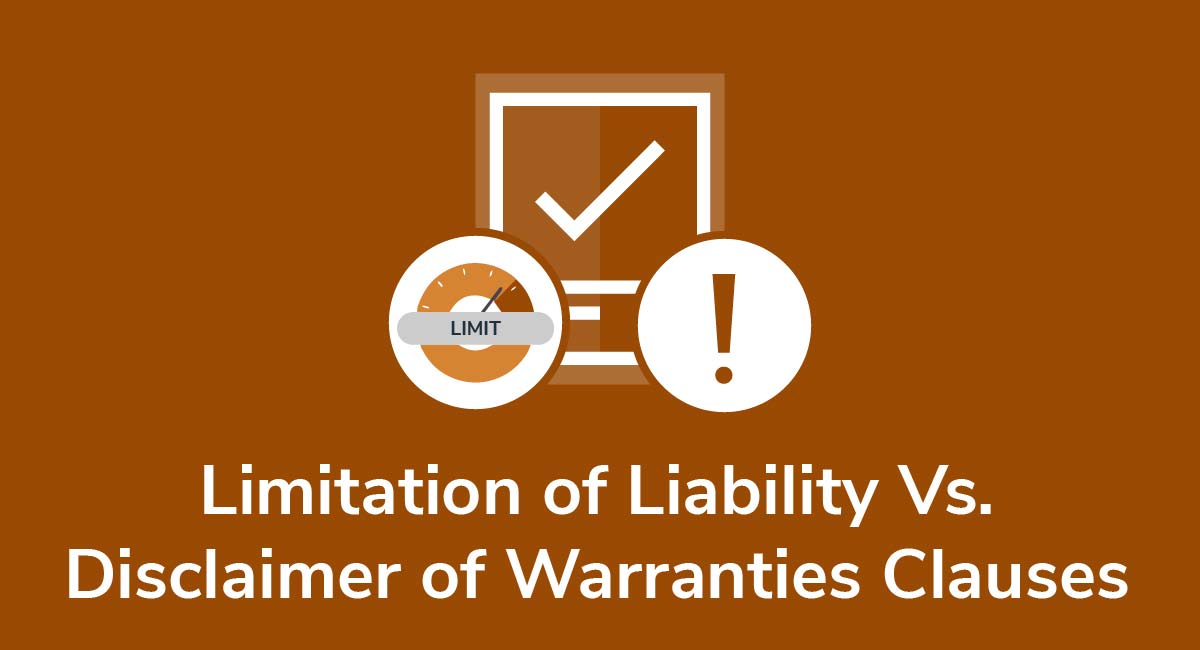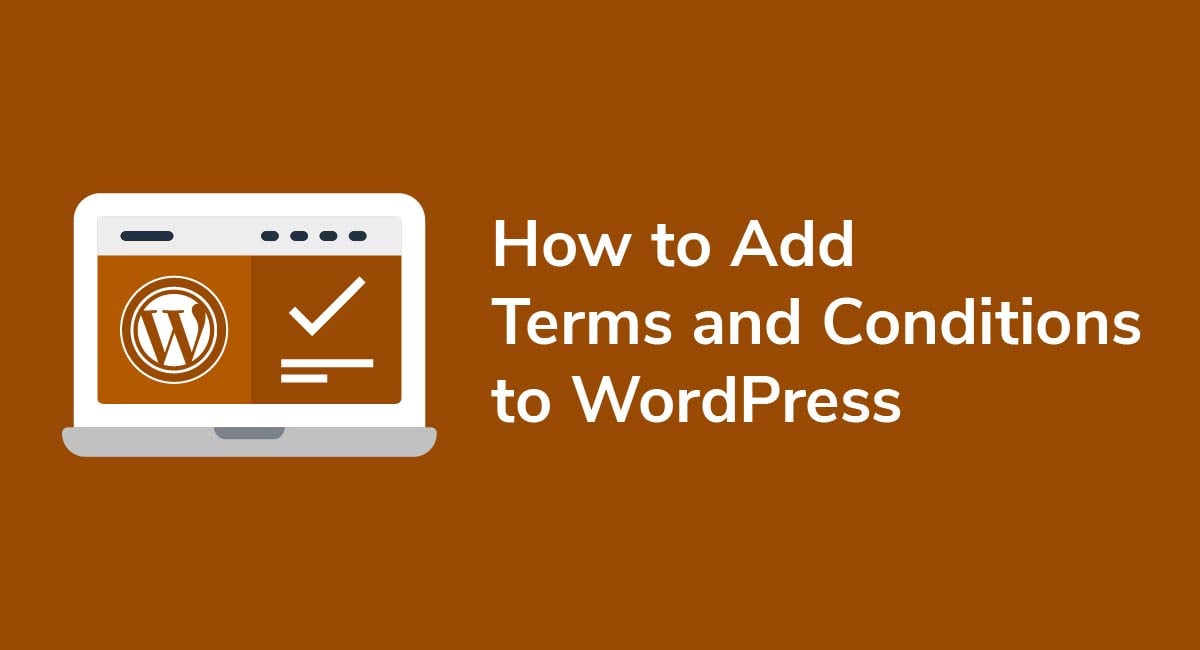Sample Terms and Conditions Template

A Terms and Conditions agreement outlines the terms that visitors must agree to if they want to interact with your website. Essentially, if the visitor continues to use the website after accepting the Terms, they enter into a contract with you.
Unlike a Privacy Policy, you aren't legally required to have a Terms and Conditions agreement. However, there are many reasons why you should draft one and display it on your website.
This article will discuss those reasons and show you a few of the most important clauses your Terms and Conditions should include.
Need Terms and Conditions for your business? We can help you generate a customized Terms and Conditions agreement in around two-three minutes for free. Try our Terms and Conditions Generator and just follow these steps:
- Click on the "Create your Terms and Conditions today" button.
- At Step 1, select the where will you use your Terms & Conditions and click "Next step":
- Add information about your business:
- Select the country and continue to the "Next step":
- Answer the questions about your business practices and click "Next step" when finished:
-
Enter your email address where you'd like your agreement sent and click "Generate."

You're done! Now you'll be able to instantly access and download your new agreement.


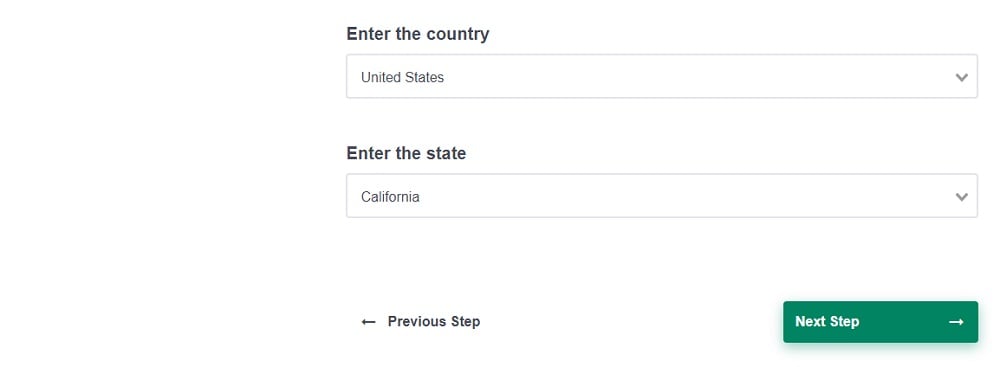
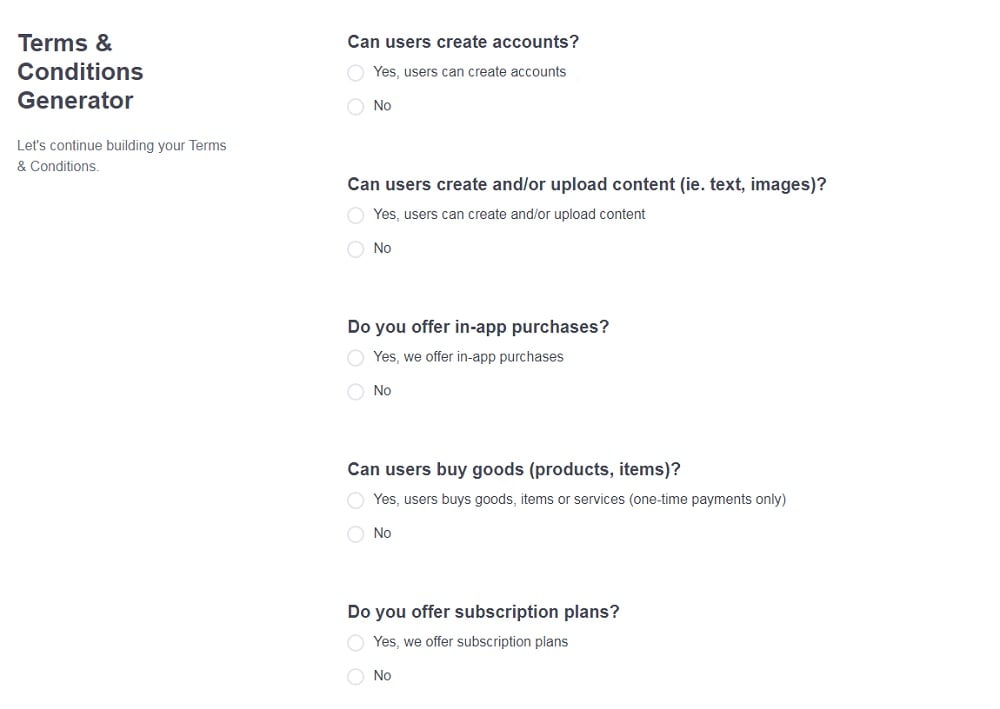
- 1. What's a Terms and Conditions Agreement?
- 2. The Benefits of Having a Terms and Conditions Agreement
- 3. Creating a Terms and Conditions Agreement
- 3.1. Introduction Clauses
- 3.1.1. Who Can Use Your Platform
- 3.2. Unacceptable Behavior Clause
- 3.3. Termination Clause
- 3.4. Jurisdiction Clause
- 3.5. Limits on Liability Clause
- 3.6. Intellectual Property Clause
- 3.7. Warranty Disclaimer Clause
- 3.8. Contact Information Clause
- 3.9. Payment Details Clause
- 3.10. Third Party Content Clause
- 3.11. Other Relevant Clauses
- 4. Displaying Your Terms and Conditions
- 4.1. Website Footer
- 4.2. Checkout Screen/Form
- 4.3. Signup/Login Form
- 5. Getting Agreement to Your Terms and Conditions
- 6. FAQ on Terms and Conditions
- 7. Conclusion
What's a Terms and Conditions Agreement?
Note that you'll sometimes see this agreement referred to as a Terms of Use, User Agreement or Terms of Service agreement. These terms are interchangeable and refer to the same type of agreement.
The purpose of a Terms and Conditions agreement is to prevent misunderstandings between the business owner (you), and the consumer. The agreement helps you:
- Protect your intellectual property
- Avoid website abuse
- Define the limits of your legal obligations to the consumer
Essentially, the T&C helps you run your business more effectively and with greater peace of mind.
This agreement forms the basis of an enforceable legal relationship. It tells anyone browsing your website, whether they are a casual visitor or an active client, what their legal responsibilities and rights are.
It also gives you, as the business owner and service provider, authority over certain undesirable things that a consumer may do on your website. However, let's consider the specific reasons why business owners should always include a Terms and Conditions agreement on their website.
The Benefits of Having a Terms and Conditions Agreement

We can't stress this enough - a T&C isn't mandatory, but you should treat it like it is. Here's why.
- You can decide which country's laws apply to govern the agreement. This is otherwise known as choosing the jurisdiction. You will generally choose the country where the website, or business, is based.
- You can remove or delete abusive accounts. For example, say you run a social media platform and explain that people who post inflammatory, abusive, or explicit content will be blocked from the service. Someone posts abusive content. You can block their account without worry, because you can rely on your Terms and Conditions agreement.
- You can limit your responsibility. You can include disclaimer clauses in your agreement that say you're not liable for third party content, and you don't endorse it. You can also say that you're not responsible for mistakes and typos, or content uploaded by users which other users may find offensive.
- You can manage a user's expectations of your website or platform. When the terms are clear, users know what they can and cannot expect from you.
- You can set your own site rules and the consequences for violating these rules, within legal limits. You can't contract out of certain rules such as the law of negligence.
- It's vital that you protect your intellectual property rights. By setting out what your rights are in the Terms and Conditions agreement, you can take action against users who infringe your rights. It should be clear that the logo, brand, and content belong to you.
Creating a Terms and Conditions Agreement

When you begin to draft a Terms and Conditions agreement, there are certain clauses you should make sure to include. Let's look at each of these clauses in turn and consider how they are drafted.
Introduction Clauses
It's very helpful to set out a clause (or clauses) at the very beginning of the agreement explaining what the agreement is, who it applies to, and when the terms are triggered.
Here's how Instagram does this. It notes that the terms are triggered when a user creates an account on the platform or uses the app, and it clearly states that the terms constitute an agreement between Instagram and the user:

It's important to clarify who the agreement applies to since it's legally binding.
YouTube, for example, makes it clear that:
- Users must agree to the terms before using the service
- Anyone who uses their service is assumed to agree to the terms
- Some people are legally prohibited from entering into the agreement

This clause is placed close to the beginning of the agreement and is part of the introductory clauses.
Who Can Use Your Platform
Although it's illegal to discriminate against people based on protected characteristics such as their gender, sexual orientation, or ethnicity, it is perfectly reasonable to put certain restrictions on who can use your website or app.
Instagram, for example, prohibits children under the age of 13 from creating accounts. It also bans convicted sex offenders.
Significantly, Instagram also bans users from returning to the site if their profile is deleted or blocked. The clause is simple but effective to include in its terms.

Helpfully, Instagram establishes why the restrictions exist - they want to comply with the law and promote a safe, inclusive platform. We recommend including reasons like these for your own clauses.
Unacceptable Behavior Clause
These clauses address what behavior is unacceptable on your website. They are an opportunity to set out the rules that you expect users to abide by, and what the consequences will be if the user violates these rules.
It's helpful to set out specific examples of behavior that violates your site rules.
The Oath Terms of Service sets out the behavior that it deems unacceptable. It uses broad language such as "Make available any content...that is otherwise objectionable" to avoid restricting content violations to, for example, sexually explicit or vulgar content:
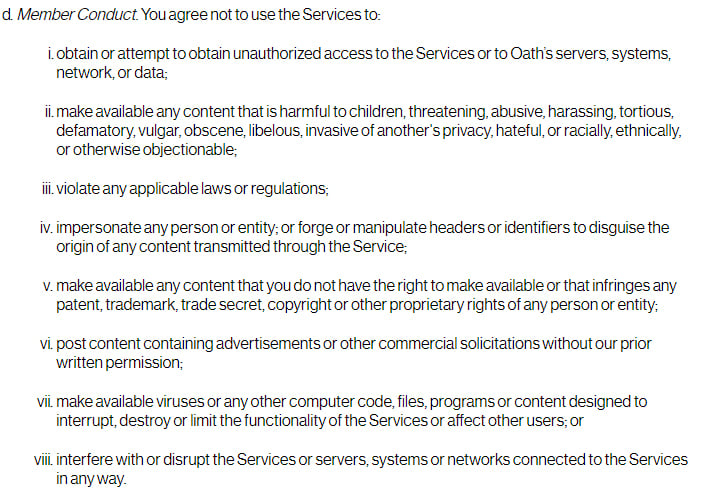
It's very important to use broad language which permits you to take action on a user's account without worrying about repercussions.
Termination Clause
Just as you should list examples of unacceptable behavior, you should explain what you're entitled to do if a user violates the agreement.
Again, YouTube does this very effectively.
The below clause explains that YouTube may or may not remove content that violates its rules, and it may or may not ban the offending user.

This gives YouTube scope to act quickly to terminate the account without giving the offending user the chance to respond. Clearly, a broadly worded clause like this one benefits you as opposed to the user, and we recommend including a clause of similar wording in your Terms agreement.
Jurisdiction Clause
You should clarify what national law you wish to have govern the agreement between you and the users. This is helpful because you can choose your local courts and laws where your business is based.
Reddit, for example, notes that all users consent to being governed by California law if they use the site:

Setting out the jurisdiction in the Terms and Conditions clarifies which courts are responsible for managing serious disputes between parties should they arise. It's important that both you and the user understand where you are entitled to sue.
Limits on Liability Clause
A limitation of liability clause lets you legally mitigate your responsibility for things that may go wrong on your website.
Facebook, for example, explains that it will exercise reasonable care and skill in delivering users the services.

Intellectual Property Clause
You should make it clear that you retain all copyright over branding, logos, and other significant business features such as domain names.
In the example below, Twitter explains that while users have full rights to use the platform, they have no right to steal its trademarks or its unique branding. It also clarifies that Twitter doesn't owe a user any credit if Twitter acts on that user's improvement suggestions or feedback.

Warranty Disclaimer Clause
You should make it clear that you aren't financially responsible for certain losses incurred while users engage with your platform or service, or use your products if you have an ecommerce store.
The exact information in your warranty clause will differ depending on what industry you're in and what terms you actually want to put forth, but a lot of warranty clauses do contain the same common language. Typically, this will be "as is" statements that you're likely familiar with seeing.
Here's an example from Snap that has the typical language and all-caps structure you'll usually see in these types of clauses:
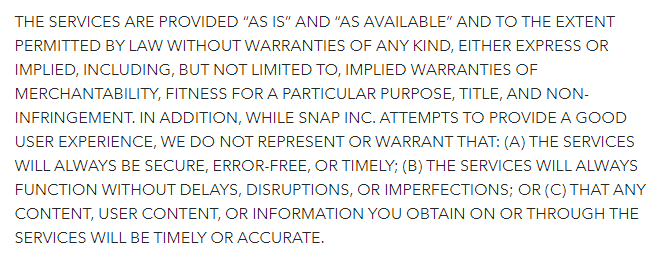
Contact Information Clause
This clause ishould outline who owns and maintains the website (usually, this is your business), and how to contact you.
Here's how Snap does this and even includes a link to an online contact form to make it even easier for users to get in touch:

Payment Details Clause
If you run a business which involves consumers signing up for paid services, such as Netflix, you should outline how payment works.
Netflix outlines the terms of membership to its platform and when payment is taken. It also clarifies that, to use the services, users must supply valid payment information and keep this information updated.

If you're running a subscription service, it's worth reading through the entire Netflix Terms of Service for some good examples of clauses as it includes a number of them that are dedicated to free trials, payment cycles, and cancellation options.
Third Party Content Clause
You shouldn't be liable for third party content available through your site, such as links placed within your site that lead elsewhere.
In the first example, Arcadia Group explains that it has no control over what happens when you click links leading to partner and third party websites:

In this second example, Reddit highlights that you click on third party links and use products supplied by Reddit partners at your own risk:

Since you can't control third party content, transferring the risk back to the user is crucial.
Other Relevant Clauses
Your Terms and Conditions agreement is personal to your business. You should include clauses that are relevant to your business type that might not be standard across industries.
WebMD, for example, rightfully specifies that the content on the platform isn't medical advice. This prevents users from relying on the content and suing WebMD if the advice is medically inaccurate for them:

Arcadia Group specifies its gift card policy, because it sells gift cards and these products are not always available:

Now that you better understand which clauses to include in your Terms and Conditions, let's look at how you should display your agreement.
Displaying Your Terms and Conditions

Your Terms and Conditions should be made available in various places. Users are not bound by terms which they can reasonably say they didn't know existed, so the more visible you make your terms, the more likely you'll be able to enforce them without issue.
There are three key places where you should display your Terms and Conditions.
Website Footer
Add a link to your agreement in the footer of your website. People know to look here for important links, including legal agreements.
Here's an example from Netflix:

Checkout Screen/Form
Before a customer completes a purchase through your website, provide a link to your agreement and consider using a checkbox to get your users to agree to the Terms explicitly:

Signup/Login Form
Don't forget to make users aware of the T&C before they sign up for your services, and even every time they log in:
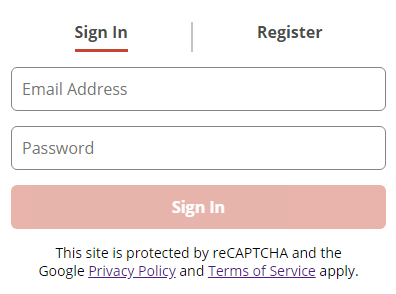
Additionally, you can display and make available your T&C and invite users to view it wherever it feels relevant to you.
Once you've got your Terms and Conditions agreement and it's displayed properly, how do you ensure users consent to it without relying on implied consent? By getting express consent.
Getting Agreement to Your Terms and Conditions

It's a basic principle of contract that no one is bound by terms which they don't know exist. If someone doesn't know they're part of a contractual relationship, you can't enforce those terms. To avoid having your users claim that they weren't aware of your terms, it's a smart idea to get the most clear and formal agreement to your Terms as possible.
For example, fashion retailer Collectif asks users to check a box before they can create an account. The box is next to a statement that says the user has "read and accepted" the Terms and Conditions. Because of this, clicking the box clearly proves that the user is accepting being bound by the Terms:

Since express agreement is always best, organizations across all sectors are adopting this checkbox style.
Pension provider NEST uses both a checkbox and an 'Accept' button for extra clarity. There is no doubt that anyone who registers for a NEST account agrees to be bound by the Terms and Conditions:

Courts generally prefer express consent over implied consent. If there's ever a dispute between you and a user over your Terms and Conditions, it's best if you can show that the user explicitly entered into a contract with your business based on these Terms.
This works the same for mobile apps. Here's how one of Adobe's mobile apps gets users to accept its Terms of Use at sign-up:
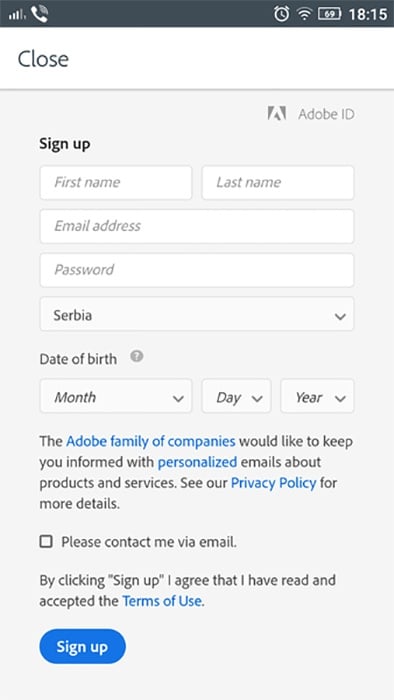
Adobe placed a sentence right above the sign up button. This sentence explicitly states that by clicking sign-up you're accepting the Terms of Use. This format and phrasing makes it very clear to users what effect clicking sign up will have.
Put simply, express consent benefits everyone. At minimum you should be having users click a button that's labeled with something like "Accept" or "Agree" and you should highly consider implementing a checkbox as well that's associated with a statement along the lines of, "I agree to be bound by the Terms and Conditions" or "By checking this box, I am agreeing to the Terms and Conditions."
FAQ on Terms and Conditions
The usual spots for your Terms and Conditions are:
- In the website footer, near the Privacy Policy
- On your sign-up form, before the "Sign-up" button
- In places where you need to get consent from users before they perform an action (e.g. Sign-up)
Conclusion
Although a Terms and Conditions agreement is not mandatory, it is something that virtually all websites have and you should treat it as a legal requirement because it's that beneficial to have.
The aim of a Terms and Conditions is to:
- Limit your liability
- Set and manage user rules and restrictions
- Outline important terms your users need to know and that you need to declare
Every Terms and Conditions should have, at minimum:
- A termination clause
- A clause limiting liability
- A clause that outlines prohibited activities
- A clause explaining that you are not responsible for third party content or activities
With a carefully crafted Terms and Conditions agreement you can reduce your time spent on consumer enquiries and avoid legal misunderstandings. However, you must also ensure that users know they are bound by these Terms, or else you can't enforce them.
